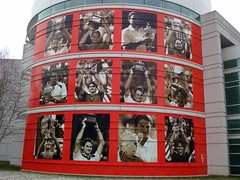Que ferait Google?
Et s'il s’agissait de la question la plus importante qu’un dirigeant d’entreprise en panne de changement ait à se poser? C’est en tout cas le titre (en anglais “What would Google do?”) de l’ouvrage de Jeff Jarvis, expert américain des médias (son blog ici), qui nous aide à mieux comprendre les changements majeurs vécus par les entreprises sous l’angle du succès de Google.
Dans une interview au Delaware online Jarvis explique le succès du géant de l’Internet par sa capacité à percevoir le monde différemment. Google joue naturellement avec les règles du monde digital et non plus du monde industriel:
“Google did not grow to be, according to the Times of London, “the fastest growing company in the world” by trying to buy and own and control everything. Instead they created platforms and networks that enabled others to succeed. Google also shows the way to having a new relationship with the public, your customers.”
Ce monde digital se caractérise, selon Jarvis, par une économie d’abondance. Réussir en contrôlant une pénurie est donc de moins en moins possible. Pour réussir dans un monde d’abondance, il faut avant tout être performant.
Autre nouvelle règle apparue avec le monde digital: un nouveau type de relation clients, évoqué ci-dessus, dans lequel l’entreprise fait confiance à ses clients, considère qu’ils sont intelligents et bien informés.
Pointés du doigt par Jarvis pour n’avoir pas ou peu su adopter ces nouvelles règles: l’industrie automobile américaine et la presse qui ont continué à fonctionner dans un monde de pénurie où les clients sont mal informés.
Face à l’émergence des nouveaux acteurs 2.0 tels que Google, on en revient donc pour les entreprises toujours à la nécessité de comprendre et mettre en oeuvre le changement, ce que souligne ici Jarvis:
“Change is inevitable. It is immutable. And the only sane response to it is to seek it out and embrace it and exploit it. That can be painful to those who resist change or who are incapable of changing. But it is inevitable and it is especially inevitable now.”
Labels: Cas et témoignages, Français, ouvrage

![Reblog this post [with Zemanta]](http://img.zemanta.com/reblog_e.png?x-id=9deed05b-bf68-41f9-a936-98fa06e870d2)

![Reblog this post [with Zemanta]](http://img.zemanta.com/reblog_e.png?x-id=b167b8c8-c940-4e67-a384-19fa1acc78d4)

![Reblog this post [with Zemanta]](http://img.zemanta.com/reblog_e.png?x-id=666b7e50-aee8-4980-9c45-8ce374fb2761)

![Reblog this post [with Zemanta]](http://img.zemanta.com/reblog_e.png?x-id=8d944fd9-90ef-419f-a22b-ecf42bbc8ff4)


